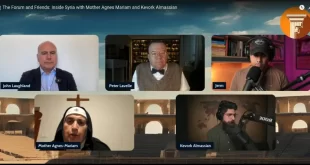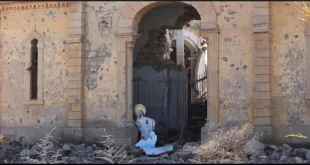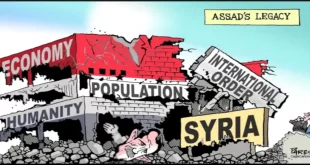April 15, 2016, Crescent Online
-by Ken Stone
The western mainstream media portray Syria as a brutal dictatorship. However, that description does not at all fit Ali Heidar, Minister for National Reconciliation of the Syrian government.
Our Second International Tour of Peace visited Mr. Heidar at 8 pm in his private office in downtown Damascus two nights ago. Like the Syrian president, the minister is an opthamologist by profession. Unlike the president, his faith community is not Alawite (cousins to the Shia Muslims) but rather Ismaili, which is yet another branch of Islam. The pluralistic nature of the Syrian government reflects the pluralistic history of Syrian society. Canadians understand pluralism. It’s something we prize.
However, what’s even more surprising is that Minister Heidar doesn’t even belong to the same party as President Assad. The minister for reconciliation is the leader of the Syrian Socialist Nationalist Party’s opposition wing and has been part of the national opposition since the crisis in Syria began in 2011. That fact did not stop the armed opposition, the terrorist foot soldiers of the West and Arab kings, from targeting one of his sons, and gunning him down in cold blood about a three years ago as he went home near the town of Houleh.
He is a charming man of middle age who has consented to talk to us on his own time in his own office after participating in an all-day cabinet meeting of the Syrian government. We tour members are pretty tired after sitting in a bus all day all the way from Beirut. But the minister seems cheerful, fresh, and welcoming. He says he wishes to be open and transparent and will entertain any question. He wants to talk about two subjects in particular: national reconciliation and refugees.
The Ministry for National Reconciliation, he says, was established three and a half years ago. It brought to a successful conclusion fifty reconciliation projects before the Russian diplomatic and military offensive started on September 30 last year. The most celebrated of these resulted 18 months ago in ten thousand terrorists abandoning the old city of Homs (which they had devastated) without firing a shot. Today, another fifty such projects are in the works.
The purpose of reconciliation is to save Syrian lives and to shorten the war.
I ask what a reconciliation project looks like.
The minister replies that the strategy is to separate the foreign fighters from Syrian fighters. So what the ministry does is to communicate with influential local people and select some of them to form a local committee of reconciliation to act its own name, formally independent of the Syrian government. The committee makes contact with the fighters and their leaders. It offers them a deal. It will provide safe passage out of a “rebel-held” area for those fighters who aren’t interested in laying down their arms and receiving amnesty. For those Syrian fighters who lay down their arms and accept amnesty, the committee promises that security records will be cleared and jobs will be found. For those who wish to remain in arms, they are invited to join the Syrian Arab Army (SAA) and can even form their own units. Eight hundred former Syrian mercenaries switched sides and joined the SAA in Latakia Province alone. President Assad granted blanket amnesties eight times in the last five years for a total of about twenty thousand former Syrian mercenaries.
But reconciliation is a lifetime project. Such bitter animosities among communities, formerly living in peace together for hundreds of years in pre-war Syria, have been created by the crimes of the foreign-backed terrorist mercenaries that many great gaps have been torn in the formerly pluralistic fabric of Syrian society. As a result, the project of reconciliation will be needed for a long time to prevent problems in the future.
As for refugees, the issue is even more complicated. There are internal and external refugees. And the Syrian government insists that it is not the cause of the either type of refugee. Rather, the refugee problem is the direct consequence of five years of a war of aggression waged against Syria by the West and Arab monarchs.
The Syrian government doesn’t know how many Syrians actually left the country because many people fled in panic of the terrorists without time even to take their documents. On the other hand, some neighbouring countries are deliberately inflating the number of Syrian refugees within their borders to leverage their political power and to get funding from aid agencies and foreign governments. For example, Lebanon registers all of its students as refugees. Jordan forces all tourists and travellers to register as refugees as well. Turkey and Jordan refuse all efforts from the Syrian government to repatriate the refugees in camps in their countries because both countries prefer that the camps remain locations where terrorist organizations can recruit male youth as new fighters (contrary to international law). Furthermore, Turkey is shamelessly exploiting the refugee issue as leverage to gain entrance to the European Union. And even worse, according to the Minister, was Turkey’s practice of promising eventual citizenship to Syrians of Palestinian origin who become refugees in Turkey, thereby undermining their right of return to Palestine.
On top of this, some Syrians living near the Lebanese border cross into Lebanon every month, posing as refugees, to collect their stipend and then return to Syria.
Internally displaced persons (IDP’s) are a heavy burden as well. Some Syrian cities have doubled and even tripled in size over the last five years due to the influx of IDP’s. Despite the shattered infrastructure and economy of Syria and despite the illegal economic sanctions levelled against Syria by western and Gulf countries, the Syrian government has somehow managed to feed, clothe, school, and medically care for some five to six million IDP’s.
(I found it really quite remarkable, if you think about it. And it belies the western demonization of the Syrian president and state. After all, if President Assad and his government are such monsters, why do so many Syrians flee the terrorists to seek refuge in government-held areas?)
Minister Heidar made it quite clear that the government’s priority to repatriate all Syrian refugees. Putting it bluntly, he said that Syria could not afford to lose so many talented people which it had trained in its own schools and universities with free education paid for from the public purse. In fact, the recent surge of Syrian refugees into Europe represents mostly Syrian students and young professionals, people the government desperately needs for reconstruction to succeed. And, while the European Union (EU) screams in fear over the refugee influx, it is making a big net gain in human capital. If it wanted to save a lot of money, the EU, instead of bribing Turkey to take refugees out of Europe, could spend a fraction of that money by giving it to the Syrian government to help repatriate its own nationals.
So what is the Syrian government doing to attract the external refugees, one member of the delegation asked.
Mr. Heidar replied that Syrian government personnel on the affected borders priorize repatriating external refugees even if they have lost all their documents. Temporary documents are issued on the spot. If refugees have security problems, efforts are made to clear personal records expeditiously. If the external refugees owned homes, they get those homes back. If not, they are provided shelter for free in resettlement centres. Many public statements offering amnesty have been made by President Assad, including a promise that opposition supporters who return will be guaranteed the right to work with the (unarmed) Syrian internal opposition. In fact, the minister pointed out that two members of the internal Syrian opposition delegation at Geneva on April 15 will be repatriated oppositional refugees.
The result has been that, in the last year, and especially after the spectacular Russian diplomatic and military offensive, large numbers Syrian refugees have been repatriated. In just the last few days, over 2000 refugees have returned home to Palmyra and Quryates.
As if on cue, there was a knock on the minister’s office door and in walked the Syrian internal opposition delegates to Geneva. Two of them were indeed former external refugees who returned to join the internal opposition. One of them made a speech to us welcoming us to Syria and requesting that we inform our countrymen and women to come to Syria to see for themselves “the real situation in the country and to appreciate the unique history, culture, and ancient civilization of Syria.”
As our peace delegation made its exit, the minister shook our hands and, noting a continuing eye problem of mine, jokingly suggested I book an examination from him. It would be free, he said!
 Syria Support Movement solidarity with the Syrian people
Syria Support Movement solidarity with the Syrian people




